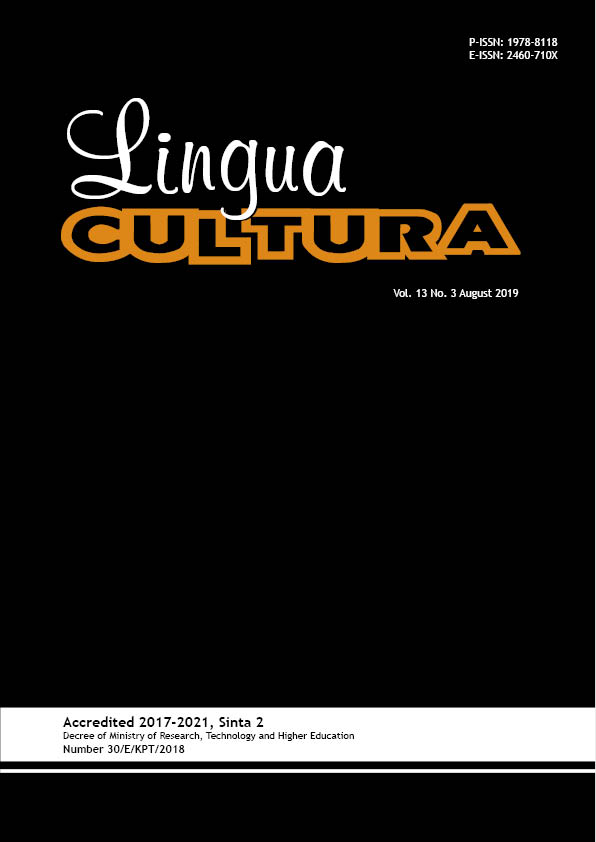Generic Structure of Tourism Promotion Website of Madura Natural Wonders
DOI:
https://doi.org/10.21512/lc.v13i3.5833Keywords:
tourism promotion, promotion website, Madura island, natural wondersAbstract
The research examined a genre-based analysis of a tourism promotion website of natural wonders on the official website of Sumenep regency. It used descriptive qualitative research. Source of the data was the Indonesian website of Sumenep regency on five natural wonders: they were tourism destinations in Gili Iyang, Gili Labak, Pantai Badur, Pantai Lombang, and Pantai Slopeng. Data collection was done by a classification of the move, step, and strategy that was proposed by Huang on sentence-based using Nvivo software. The findings yield from the proposed move and steps, and there are only four moves available compared to the proposed move and step. They comprise the move 1 headline, move 2 establishing credentials, move 3 directive information, move 4 soliciting response, and four steps in move 2 comprises step 1 introducing general situation, step 2 quoting literature, step 3 describing services or facilities, and step 4 describing critical attractions in the tourism promotion official website. The four moves found in official websites become obligatory because all moves are available in all contents of the tourism promotion website. The establishing credential move occupies the large portion of the website in giving information about the destination. Move 2 steps 2 quoting literature and move four could be categorized into non-obligatory moves because of those moves only available in one of the tourism promotions in the official website of Sumenep regency.
References
Bhatia, V. K. (2004). Worlds of written discourse. London: Continuum.
Bhatia, V. K. (2005). Generic patterns in promotional discourse. In Halmari & Virtanen (Eds), Persuasion Across Genres: A Linguistic Approach (pp. 213-225). Amsterdam: John Benjamins Publishing.
De los Rios, M. E. C., & Hernandez, A. C. (2016). The promotion of health and beauty tourism through websites: A linguistic analysis. Revista de Lengues Para Fines Expecificos, 22(2), 62-83.
Fernandes-Cavia, J., & Castro, D. (2015). Communication and branding on national tourism websites. Cuadernos Info, 37(2), 167-185. doi:10.7764/cdi.37.682.
Huang, S. (2015). A genre-based analysis of brief tourist information texts. Joint International Social Science, Education, Language, Management and Business Conference. Chongqing, China. pp. 191-202.
Janice, Y. L. I. (2008). Analyzing tourism discourse: A case study of a Hong Kong travel brochure. LCOM Papers, 1, 1-19.
Kristina, D., Hashima, N., & Hariharan. (2017). A genre analysis of promotional texts in an Indonesian batik industry. Indonesian Journal of Applied Linguistics, 7(2), 425-435.
Labrador, B., Noelia, R., Moreton, H. A., & Sanjurjo- Gozalez, H. (2014). Rhetorical structure and persuasive language in the subgenre of online advertisements. English for Specific Purposes, 34, 38-47.
Luo, J., & Huang, T. (2015). Genre-based analysis of American tourism brochure. Open Journal of Social Sciences, 3(9), 200-208.
Sitthanakul, K., & Dhanesschaiyakupta, U. (2017). An analysis of move and linguistic characteristic of hotel homepages. PEOPLE: International Journal of Social Science, 3(2), 1057-1076. doi:https://dx.doi.org/10.20319/pijss.2017.32.10571076.
Yaemwannang, C., & Pramoolsook, I. (2018). Move and writing strategy analysis of international hotel homepages. The Journal of Teaching English for Specific and Academic Purposes, 6(1), 83-95. https://doi.org/10.22190/JTESAP1801083Y.
Downloads
Published
How to Cite
Issue
Section
License
Authors who publish with this journal agree to the following terms:
a. Authors retain copyright and grant the journal right of first publication with the work simultaneously licensed under a Creative Commons Attribution License - Share Alike that allows others to share the work with an acknowledgment of the work's authorship and initial publication in this journal.
b. Authors are able to enter into separate, additional contractual arrangements for the non-exclusive distribution of the journal's published version of the work (e.g., post it to an institutional repository or publish it in a book), with an acknowledgment of its initial publication in this journal.
c. Authors are permitted and encouraged to post their work online (e.g., in institutional repositories or on their website) prior to and during the submission process, as it can lead to productive exchanges, as well as earlier and greater citation of published work.
USER RIGHTS
All articles published Open Access will be immediately and permanently free for everyone to read and download. We are continuously working with our author communities to select the best choice of license options, currently being defined for this journal as follows: Creative Commons Attribution-Share Alike (CC BY-SA)


















